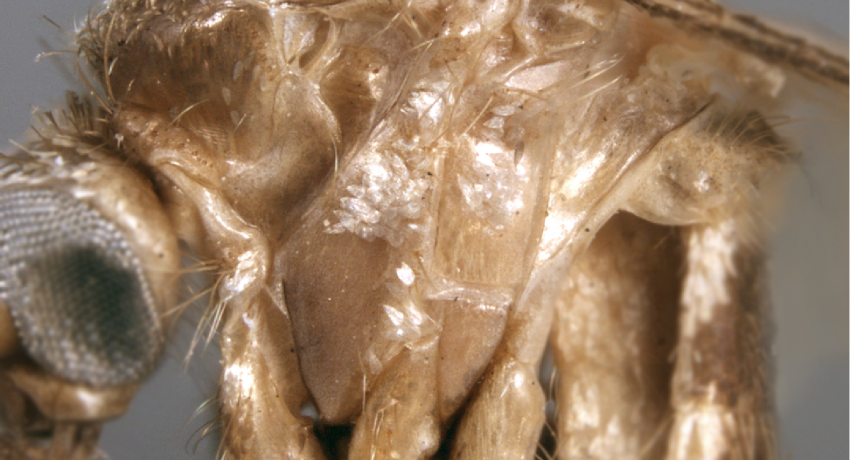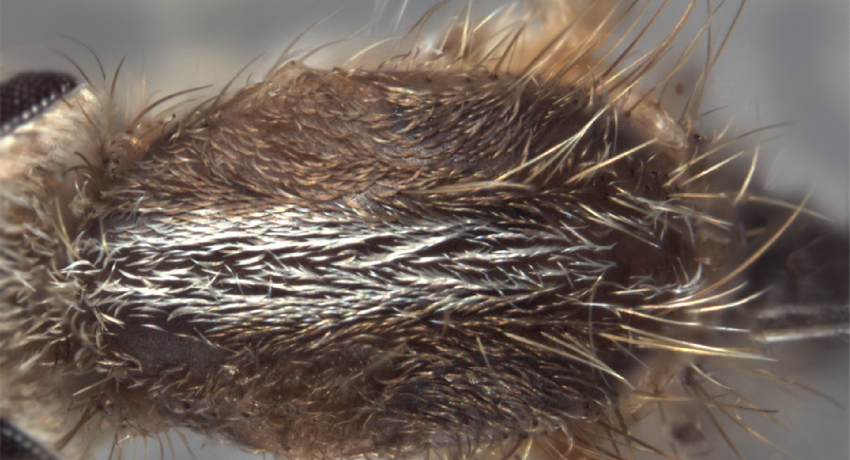NEARCTIC REGION
Etymology: Atlantic; oceanic region of North America
Aedes atlanticus is a pest species across much of its range. Although generally dark in color, Aedes atlanticus have a broad median stripe of white scales on their heads that stretch forward between the eyes, and a narrow strip of silvery-white to pale yellow scales along the whole length of their scutum. Aedes atlanticus is one of ten species assigned to the Protoculex Group.
Type locality: New Jersey, and Sanford, Florida, United States
Type depository: Type non-existent (NE)
DIAGNOSTIC CHARACTERS (Click photos to view; mouse over and click large photo to zoom in.)
ADULT (illustrated): Head: Lateral black scale patches extend forward to eye margin. Thorax: Median longitudinal white stripe along entire length of scutum, narrower than lateral brownish areas. Antepronotum and postspiracular area without pale scales; paratergite scales absent; postprocoxal membrane bare; subspiracular scales absent. Leg: Ta-III without pale bands.
LARVA (not illustrated): Head: Setae 5,6-C gradually tapering from base; seta 8-C long, reaching forward to base of seta 5-C. Terminal segments: Comb scales 4–6, in single row; siphon width about equal to width of segment X; siphon index c. 2.0–2.5; seta 1-S inserted at or beyond last pecten spine; seta 2-X distinctly shorter than seta 3-X; anal papillae ≤5 x width of segment X.
TAXONOMIC KEYS
Carpenter & LaCasse 1955
King et al. 1960
Ross & Horsfall 1965
Dodge 1966
Darsie & Ward 2005
Harrison et al. 2016
Exemplar DNA sequences
Ae. atlanticus COI: JX259518–19, MG242469
BIONOMICS
Immatures
Aedes atlanticus oviposit in a wide variety of floodwater sites, both in open and wooded areas. Larvae are found in temporary pools in open fields and woodlands, and often in association with Ae. infirmatus Dyar & Knab. In coastal areas, the immatures can sometimes occupy brackish water sites. In Virginia, larvae have been reported from March to November.
Adults
Female Ae. atlanticus are crepuscular—commonly found biting at dawn and dusk in shaded areas, but they can also be lured to feed in bright sunlight. Hosts include humans and a wide range of mammals, birds and reptiles. Adults are closely associated with the immature habitats. They are weak fliers, with short flight ranges noted of only up to half a mile. Peak adult abundance occurs in spring and fall.
DISTRIBUTION NOTES
Guatemala, Mexico, United States (Continental).

WRBU VECTOR HAZARD REPORTS
None; View other WRBU Vector Hazard Reports
Available GIS Models:
None
IMPORTANT REFERENCES (full citations below)
Dyar & Knab 1906d: 198 (L*; as Aedes)
Yamaguti & LaCasse 1951d: 29 (M*, F*, L*)
Carpenter & LaCasse 1955: 151 (M*, F*, L*; keys, bionomics)
Stone & Knight 1956a: 214 (type information)
Craig & Horsfall 1960 (E*)
King et al. 1960: 66 (M, F*, L; keys)
Ross & Horsfall 1965 (M*, F*, L*, E*; keys)
Dodge 1966: 348 (1st instar L*; key)
Horsfall et al. 1970: 1711 (E*)
Scanlon & Yates 1970 (taxonomy)
Mattingly 1971a: Pl. 33 (L head*, terminal segments*)
Reinert 1971: 171 (P*)
Roberts & Scanlon 1979 (F*; taxonomy)
Darsie & Ward 2005 (F*, L*; keys, distribution)
Harrison et al. 2016 (F*, L*; keys, distribution)
CURRENT SYNONYMS
None
CITED REFERENCES
Carpenter, S.J., & LaCasse, W.J. (1955). Mosquitoes of North America (North of Mexico). Berkeley, Los Angeles: University of California Press.
Craig Jr., G.B., & Horsfall, W.R. (1960). Eggs of floodwater mosquitoes. VII. Species of Aedes common in the Southeastern United States (Diptera: Culicidae). Annals of the Entomological Society of America, 53(1), 11–18.
Darsie, R.F., Jr., & Ward, R.A. (2005). Identification and geographical distribution of the mosquitoes of North America, north of Mexico. Gainesville, FL: University Press of Florida.
Dodge, H. R. (1966). Studies on mosquito larvae. II. The first-stage larvae of North American Culicidae and of world Anophelinae. Canadian Entomologist, 98, 337–393.
Dyar, H.G., & Knab, F. (1906d). The larvae of Culicidae classified as independent organisms. Journal of the New York Entomological Society, 14, 169–230.
Harrison, B.A., Byrd, B.D., Sither, C.B., & Whitt, P.B. (2016). The mosquitoes of the Mid-Atlantic Region: an identification guide (Vol. 1). Madison Heights, MI: Publishing XPress.
Horsfall, W.R., Voorhees, F.R., & Cupp, E.W. (1970). Eggs of floodwater mosquitoes. XIII. Chorionic sculpturing. Annals of the Entomological Society of America, 63, 1709–1716.
King, W.V., Bradley, G.H., Smith, C.N. & Mcduffie, W.C. (1960). A hand book of the mosquitoes of the southeastern United States. Agricultural Handbook, USDA.
Mattingly, P.F. (1971a). Contributions to the mosquito fauna of Southeast Asia. XII. Illustrated keys to the genera of mosquitoes (Diptera, Culicidae). Contributions of the American Entomological Institute, 7(4), 1–84.
Reinert, J.F. (1971). Descriptions of the pupae of Aedes (Ochlerotatus) atlanticus and Aedes (O.) tormentor (Diptera: Culicidae). Florida Entomologist, 54, 171–178.
Roberts, D.R., & Scanlon, J.E. (1975). The Ecology and Behavior of Aedes atlanticus D. & K. and other species with reference to Keystone Virus in the Houston area, Texas. Journal of Medical Entomology, 12(5), 537–546.
Roberts, D.R., & Scanlon, J.E. (1979). An evaluation of morphological characters for separating females of Aedes (Ochlerotatus) atlanticus Dyar and Knab, and Aedes (Ochlerotatus) tormentor Dyar and Knab (Diptera: Culicidae). Mosquito Systematics, 11(3), 203–208.
Ross, H.H., & Horsfall, W.R. (1965). A synopsis of the mosquitoes of Illinois (Diptera, Culicidae). Illinois Natural History Survey Biological Notes, 52, 1–50.
Scanlon, J.E., & Yates, M.M. (1970). Preliminary observations on Aedes (Ochlerotatus) atlanticus Dyar and Knab 1906, and other members of the Scapularis species group in Texas. Proceedings of the Texas Mosquito Control Association, 9–10.
Stone, A., & Knight, K.L. (1956a). Type specimens of mosquitoes in the United States National Museum. II. The genus Aedes (Diptera, Culicidae). Journal of the Washington Academy of Sciences, 46(7), 213–228.
Yamaguti, S., & LaCasse, W.J. (1951d). Mosquito fauna of North America Part V – Genus Aedes. Office of the Surgeon General, Headquarters, 8th Army, APO 343. United States. 207th Malaria Survey Detachment.
CITE THIS PAGE
Walter Reed Biosystematics Unit (Year). Aedes atlanticus species page. Walter Reed Biosystematics Unit Website, http://wrbu.si.edu/vectorspecies/mosquitoes/atlanticus, accessed on [date (e.g. 03 February 2020) when you last viewed the site].









































































































































































